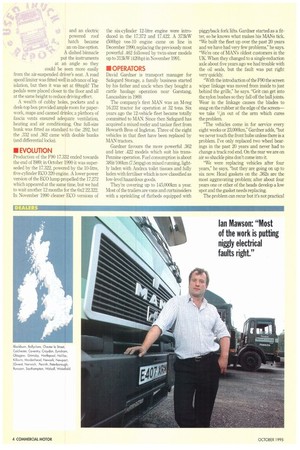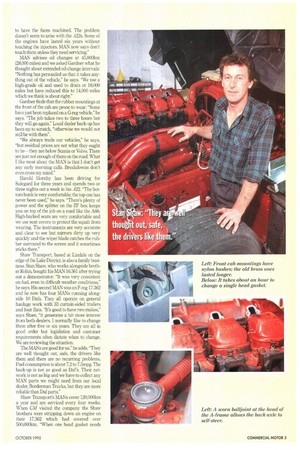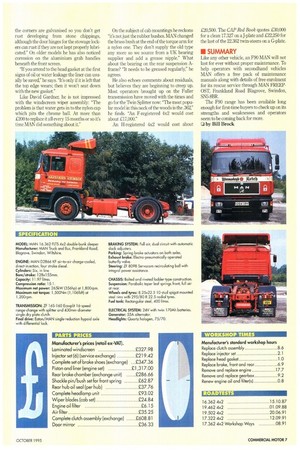• When MAN collaborated with Saviem to produce the F8
Page 56

Page 58

Page 59

Page 60

Page 61

If you've noticed an error in this article please click here to report it so we can fix it.
heavy truck cab hack in 1961 it must have done something right because it was to be another 25 years before it was changed for the current F90 cab. Even then its outward appearance didn't change that much, but it became lighter and easier to produce.
As usual right-hand-drive models took a little time to make their way across the Channel, finally becoming available in mid 1987. The following January the 17.332 4x2 tractive unit replaced the 16.332, taking advantage of the increased 17-tonne two-axle limit. The new model kept its 6.7-tonne front axle and Eaton/MAN 13-tonne hypoid drive axle.
The 12-litre, six-cylinder, charge-cooled engine, rated at 242kW (324hp), gained modified breathing and cooling. It drove through the Eaton Twin Splitter TS011612 12-speed constant.mesh box which was also used in the more powerful 266kW (356hp) version, and in the 22.292 and 22.332 twin-steer tractors.
Although the F90 cab was wider, GRP panels in vulnerable areas reduced its weight by 200kg. This offset the extra weight of the cab's four-point coil-spring suspension on top-ofthe-range models, and a larger fuel tank. Height and rake adjustment of the steering wheel allowed a greater choice of driving position: the nearside window and both rearview mirrors gained electric adjustment Po and an electric powered roof hatch became an on-line option. A dished binnacle put the instruments at an angle so they could be seen more easily from the air-suspended driver's seat. A road speed limiter was fitted well in advance of legislation, but then it was set at 69mph! The pedals were placed closer to the floor and all at the same height to reduce driving effort. A wealth of cubby holes, pockets and a desk-top box provided ample room for paperwork, maps and canned drinks; a plethora of fascia vents ensured adequate ventilation, heating and air conditioning. One full-size bunk was fitted as standard to the .292, but the .332 and .362 came with double bunks (and differential locks).
• EVOLUTION
Production of the F90 17.332 ended towards the end of 1989; in October 1990 it was superseded by the 17.322, powered by the 10-litre, five-cylinder ECO 320 engine. A lower power version of the ECO lump propelled the 17.272 which appeared at the same time, but we had to wait another 12 months for the 6x2 22.322. In November 1990 cleaner ECO versions of the six-cylinder 12-litre engine were introduced in the 17.372 and 17.422. A 373kW (5(0hp) vee-10 engine came on line in December 1990, replacing the previously most powerful .462 followed by twin-steer models up to 313kW (420hp) in November 1991.
• OPERATORS
David Gardner is transport manager for Safegard Storage, a family business started by his father and uncle when they bought a cattle haulage operation near Garstang, Lancashire in 1969.
The company's first MAN was an M-reg 16.232 tractor for operation at 32 tons. Six years ago the 12-vehicle fleet became totally committed to MAN. Since then Safegard has acquired a mixed reefer and tanker fleet from Howarth Bros of Ingleton. Three of the eight vehicles in that fleet have been replaced by MAN tractors.
Gardner favours the more powerful .362 and later .422 models which suit his transPennine operation. Fuel consumption is about 381it/100km (7.5mpg) on mixed running, lightly laden with Andrex toilet tissues and fully laden with fertiliser which is now classified as low-level hazardous goods.
They're covering up to 145,0001cm a year. Most of the trailers are vans and curtainsiders with a sprinkling of flatbeds equipped with piggyback fork lifts. Gardner started as a fitter, so he knows what makes his MANs tick. We built the fleet up over the past 20 years and we have had very few problems," he says. "We're one of MAN's oldest customers in the UK. When they changed to a single-reduction axle about five years ago we had trouble with the oil seals, but the fault was put right very quickly.
"With the introduction of the F90 the screen wiper linkage was moved from inside to just behind the grille," he says. "Grit can get into the nylon bushes so they fall off the ball joints Wear in the linkage causes the blades to snag on the rubber at the edge of the screen— we take 1/1in out of the arm which cures the problem.
"The vehicles come in for service every eight weeks or 23,000km," Gardner adds. "but we never touch the front hubs unless there is a problem. I've only replaced two wheel bearings in the past 20 years and never had to change a track rod end. On the rear we are on air so shackle pins don't come into it.
"We were replacing vehicles after four years," he says, "but they are going on up to six now. Head gaskets on the .362s are the most aggravating problem; after about four years one or other of the heads develop a low spot and the gasket needs replacing.
The problem can recur but it's not practical to have the faces machined. The problem doesn't seem to arise with the .422s. Some of the engines have lasted six years without touching the injectors. MAN now says don't touch them unless they need servicing" MAN advises oil changes at 45,000km (28,000 miles) and we asked Gardner what he thought about extended oil-change intervals: "Nothing has persuaded us that it takes anything out of the vehicle," he says. "We use a high-grade oil and used to drain at 18,000 miles but have reduced this to 14,000 miles which we think is about right."
Gardner finds that the rubber mountings at the front of the cab are prone to wear: "Some have just been replaced on a G-reg vehicle," he says. "The job takes two to three hours but they will go again." Local dealer back-up has been up to scratch, "otherwise we would not still be with them".
"We always trade our vehicles," he says, "but residual prices are not what they ought to be—they are below Scania or Volvo. There are just not enough of them on the road. What I like most about the MAN is that I don't get any early morning calls. Breakdowns don't even cross my mind."
Harold Hornby has been driving for Safegard for three years and spends two or three nights out a week in his .422. "The bottom bunk is very comfortable; the top one has never been used," he says. "There's plenty of power and the splitter on the IF box keeps you on top of the job on a road like the A66. High-backed seats are very comfortable and we use seat covers to protect the squab from wearing. The instruments are very accurate and clear to see but mirrors dirty up very quickly and the wiper blade catches the rubber surround to the screen and it sometimes sticks there."
Shaw Transport, based at Lindaie on the edge of the Lake District, is also a family business. Stan Shaw, who works alongside brother Robin, bought his MAN 16.361 after trying out a demonstrator: "It was very consistent on fuel, even in difficult weather conditions," he says. His second MAN was an F-reg 17,362 and he now has four MANs running alongside 10 Dafs. They all operate on general haulage work with 33 curtain-sided trailers and four flats. "It's good to have two makes," says Shaw, "it generates a bit more interest from both dealers. I normally like to change them after five or six years. They are all in good order but legislation and customer requirements often dictate when to change. We are reviewing the situation.
The NLA.Ns are good for us," he adds. "They are well thought out, safe, the drivers like them and there are no recurring problems. Fuel consumption is about 7.2 to 7.5mpg. The back-up is not as good as Des. Their network is not as big and we have to collect any MAN parts we might need from our local dealer, Borderman Trucks, but they are more reliable than Daf parts."
Shaw Transport's MAINs cover 120,000km a year and are serviced every four weeks. When CM visited the company the Shaw brothers were stripping down an engine on their 17.362 which had covered over 500,000km. "When one head gasket needs
doing we • replace them all at the same time," says Shaw.
The bushed bail joint at the head of the A-frame locating the rear air suspension is subject to wear, he finds. When it does there is no mistaking the selfsteering action and increased tyre wear that accompanies the floating action of the back axle. Shaw's solution is simply to fit a grease nipple before wear sets in. He also reckons that the air suspension is slow to equalize as the vehicle goes through a corner.
When replacing vehicles the old model is usually part exchanged, but Shaw accepts that while this probably secures a better residual price, "you lose some of the advantage in bargaining for the new one". As long as MANs stay competitive on delivery times and prices he'll probably stick with them, but says that at present "it's dearer than the Dafenough to make you think again."
With 356 MAN rigids and tractors in TNT Express UK's 3,000 strong fleet, Director of Engineering Alan Parker has plenty of experience of the Munich-built marque.
TNT's 138 F90 tractors are primarily fivecylinder models with the majority being 17.322s although there are a few 17.272s as well Most have the Eaton Twin Splitter 12speed with a handful now specified with the latest S-Series Eaton synth° box modified specially from a 16-speed to a 12-speed.
The bulk of F90s are running between 32 38 tonnes split 50/50 between lowdensity/high-volume parcels work trunking into the Atherstone hub and TNT's high density, long-haul TNT Logistics work and its Newsfast newspaper and magazine nationwide distribution contract. On average the TNT F90s are returning around 8.5-9mpg although Parker reports that "on some operational duty cycles we can get well into the nines on 32/38 tonne operations".
"In the past 12 months a lot of the niggling problems we previously had with the F90s have been engineered out so now they're very reliable", he says. "On tractors the one niggling bit we do have is with the offside front, rear spring shackle. The heat from the exhaust system is directly below the area and dries out the grease. But MAN is working on it with us.
"When it comes to helping with problems they're very good— and when we talk to other fleet operators the same message comes over," says Parker.
TNT keeps its express delivery tractors for five years while Newsfast vehicles go after two and a half and Parker says: "That's obviously a reflection of their operational duties. Over five years they'll cover a million kilometres easily and we wouldn't expect any major com
ponent failure during that time. They are a million kilometre motor—although to be fair to the rival makes we also run so are the others." When it's time to part with his F90s Parker is more than happy with their secondhand value. "The guaranteed residuals we receive from MAN are very good and certainly very competitive to marques who have in the past been held to be the benchmark."
• DEALERS
Chris Hodge is one of the largest independent dealers in the UK. At his Greenwich base he has a stock of some 300 vehicles from 7.5 tonnes upwards; most of them less than five years old.
"There are not that many MANs out there," he says, "but the one we see most of is the 17.322 4x2 tractive unit. Some of the large fleets use them and when they come to us they tend to be in large numbers. The more powerful MAN models are more likely to be one-offs.
"Operators like the cab," he adds. "It's got a flat floor, the dash is OK, they're quiet and the ride is quite good. The seat adjustment tends to wear as they get older and can be expensive to put right. The 320hp five-cylinder engine can be a bit lumpy on tickover, but we've never had one that's given us any trouble. They're specified with the Eaton Twin Splitter transmission which calls for a little driver education. We get some very nice ones which are easy to sell, but prices do vary with age and condition. You could expect to pay anything between £16,000 and £20,000 for a J-reg 17.322, which is most likely to be on a 3.2m wheelbase."
One of MAN'S original dealer franchises, Borderman (Trucks) at Penrith, is owned by an operator, so service manager Ian Mawson wears two hats as he is also responsible for the maintenance of Barnett and Graham's 24 tractors and 90 trailers.
"We don't get a lot of comeback on warranty," says Mawson, "most of the work is putting niggly electrical faults right."
He likes the cab: "The front is plastic and the corners are galvanised so you don't get rust developing from stone chippings, although the door hinges for the stowage lockers can rust if they are not kept properly lubricated." On older models he has also noticed corrosion on the aluminium grab handles beneath the front screen.
"If you attend to the head gasket at the first signs of oil or water leakage the liner can usually be saved," he says. "It's only if it is left that the top edge wears; then it won't seat down with the new gasket."
Like David Gardner, he is not impressed with the windscreen wiper assembly: "The problem is that water gets in to the nylon cap which pits the chrome ball. At more than 000 to replace it all every 15 months or so it's time MAN did something about it." On the subject of cab mountings he reckons "it's not just the rubber bushes. MAN changed the brass bush at the end of the torque arm for a nylon one. They don't supply the old type any more so we source from a UK bearing supplier and add a grease nipple." What about the bearing on the rear suspension Aframe? "It needs to be greased regularly," he agrees.
He also echoes comments about residuals, but believes they are beginning to creep up. Most operators brought up on the Fuller transmission have moved with the times and go for the Twin Splitter now: "The most popular model in this neck of the woods is the .362," he finds. "An F-registered 4x2 would cost about L17,000."
An II-registered 4x2 would cost about
£20,500. The CAP Red Book quotes £30,000 for a clean 17.327 on a 1-plate and £22,250 for the last of the 22.362 twin-steers on a G-plate.
• SUMMARY
Like any other vehicle, an F90 MAN will not last for ever without proper maintenance. To help operators with secondhand vehicles MAN offers a free pack of maintenance manuals along with details of free enrolment for its rescue service through MAN FREEPOST, Frankland Road Blagrove, Swindon, SN5 8BR.
The F90 range has been available long enough for first-time buyers to check up on its strengths and weaknesses and operators seem to be coming back for more.
CI by Bill Brock












































































































































